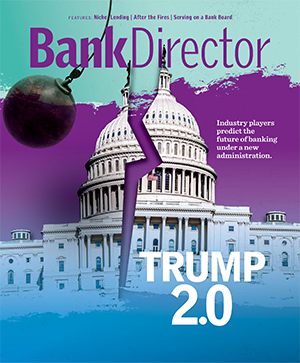
Why Banks Aren’t Rushing to Instant Payments
Instant payments are here and many banks aren’t ready.
The launch of FedNow from the Federal Reserve is a catalyst that could reshape payments in the United States.
But faster payments have yet to penetrate the majority of banks. Only 13% of respondents say they’ve added Real Time Payments, which The Clearing House released in 2017, according to Bank Director’s 2023 Technology Survey. Only 35 banks and credit unions were live with FedNow capabilities when it was released in July, according to the Federal Reserve.
“We have provided the rails,” said Federal Reserve Vice Chair for Supervision, Michael Barr, in a September speech. “Innovation by private depository institutions will determine whether these services reach a broad range of households and businesses … While current volumes on FedNow are small, I expect that participation will grow over time and be a significant addition to, and advance on, the existing payments infrastructure.”
Technology
One major impediment to banks adding faster payment capabilities is technology. Luther Liang, director of product at $718 million Grasshopper Bank, points out that many banks are satisfied with the limitations that come with daily batch payments processing, or allow their card network or processors to manage some of the risk control functionality for those payments.
“I think that’s going to be the biggest thing to solve,” he says. “It’s a complete rethink.”
Banks may need to amend or alter some of the “core components” of their technology stack to facilitate faster payments, says Matt DeLauro, chief revenue officer at fraud-fighting firm SEON.
Those could include processing and reconciliation systems and liquidity monitoring, as well as their staffing, to identify gaps that wouldn’t support payments that are around-the-clock and instantaneous.
For its part, Grasshopper, a unit of New York-based Grasshopper Bancorp, hasn’t gone live with FedNow. The bank began operations in 2019; Liang says it still has some other fundamentals to fully establish before adding instant payments. But, he adds, executives are evaluating how faster payments fit into the bank’s road map.
Fraud
Banks interested in rolling out faster payment capabilities should start with what DeLauro calls a “fraud audit.” To that end, FedNow’s launch can be a call to action within compliance and risk management teams to reexamine the bank’s technology stack, precautions and customer behavior.
“If you’re not auditing yourself, the fraudsters are auditing you,” he says.
The speed of faster payments doesn’t increase vectors for fraud, but an audit may reveal that a bank needs faster and automated tracking systems to keep up. FedNow does come with some fraud-detection and mitigation tools that financial institutions can take advantage of, but DeLauro says they may still need to improve their security posture and layer on vendors that can assist with know-your-customer verification, fraud monitoring, device recognition and intelligence. Some of these technologies can identify “pre-fraud” and indicate transactions or actors that are likely fraudulent before a transaction settles.
“You’re shortening the detection cycle – the ability to [detect fraud and stop it] before the cash leaves the account,” says DeLauro. “If the payments are in real time, your fraud detection needs to be in real time.”
Banks also need to consider the risks, controls and limits around those transactions before going live. Liang points out that banks should communicate to clients about their sending limits, the number or amount of transactions, and educate them on potential fraud and scams they may encounter. On the other hand, migrating customers to instant payment methods may help banks reduce other types of payment fraud, especially check fraud, Chris Nichols, director of capital markets at SouthState Bank, argues in a recent post.
Use Cases
So far, demand from businesses and commercial customers for faster and real-time payments has been low, according to both Liang and DeLauro. One reason is that there are several payment options that businesses seem happy to use, Liang says. None of Grasshopper’s small business clients have reached out to ask when the bank will launch FedNow. They may not know it exists, he adds.
That means the work is on banks to explore potential applications and use cases, based on their customers’ businesses and need for payments. Liang likes to apply the “jobs to be done” project management concept to explore use cases: What is a business trying to solve in their specific context and how could a faster payment help them?
Those applications could become increasingly important as community banks compete to attract prospective small business customers, DeLauro says. Especially among the smallest businesses, payment speed and cash flow are increasingly important factors that could influence who they choose to bank with. Right now, he says that’s not the principal factor most businesses use, relative to other variables like financing and credit availability.
“I don’t look at it as something that the market is demanding, where the [banks] that adopt FedNow are going to get this big rush of depositors and [businesses] are going to leave some bank they’ve been with for 10 years because somebody else clears payments in two days,” he says. “I think it’s important, but it’s not a decision factor.”
Coming up with use cases may involve an evolution in bank thinking, says Peter Davey, venture partner at Alloy Labs, a consortium of community banks. Before joining Alloy Labs, Davey worked at The Clearing House and helped develop Real Time Payments.
He says the majority of community banks focus primarily on lending. Smaller banks may have relied on their vendors to create the payment products, rather than designing and exploring new capabilities. Payments may have been a loss leader for those institutions. Some community banks may decide to change that and figure out how faster payments can become part of a differentiated service offering and revenue line.
“I think the reality of banking is changing, and it’s becoming less transactional and more service-oriented,” Davey says.
Questions for Banks to Answer
- What is our bank’s commercial client segment and what kind of payments are they making or need to make?
- Are there business segments we want to serve where payment capabilities, timing and reconciliation could be a differentiator for us?
- When was the last time the bank conducted a risk audit? What does our risk control tower look like, and where are the gaps in our systems? What are our current fraud- and scam-fighting tactics?
- How much do our current vendors dictate our payments capabilities? Is this something we should try to own or control by finding new technology providers?
- Do our fraud-monitoring capabilities match our current payment speeds? Does our tech stack need to be upgraded to reflect the changing nature of payments and increasing speed?



